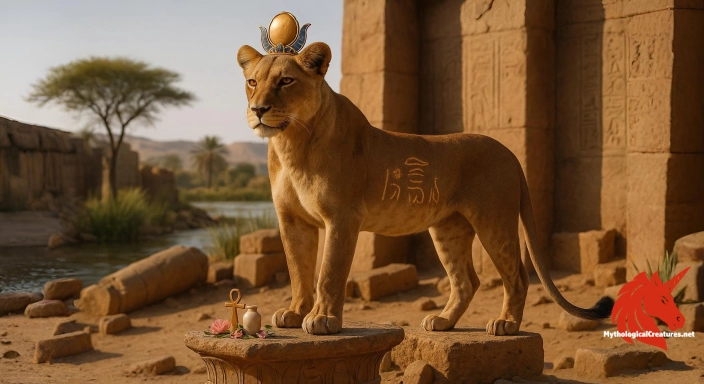Tepoztēcatl: Tepoztēcatl is the Aztec god of pulque, drunkenness, and fertility, intimately linked with the natural world through his control over wind and the sacred maguey.

Tepoztēcatl
Tepoztēcatl - Embodies the sacred aspects of intoxication and fertility in Aztec culture, bridging the natural fermentation process with divine influence.
Origins & First Encounters
Tepoztēcatl emerges as a vibrant and enigmatic figure within Aztec myth, embodying the delicate interplay between fertility, intoxicating ecstasy, and the elemental force of the wind. His origins are interwoven with the rich tapestry of Mesoamerican creation narratives, and his name—rooted in terms for "workable metal" and "person"—hints at the transformative qualities inherent in his nature. Born into a divine lineage through his association with Mayahuel and Patecatl, his existence links the sacred maguey plant with the mysteries of fermentation and life itself. His calendrical name, Ometochtli or "two-rabbit," further reinforces his connection to cyclical time and dualities that govern existence. Early depictions found in codices such as the Mendoza Codex testify to his importance, and his portrayal with a copper axe symbolises both creative artistry and ritualistic power. His role as the god of pulque shines a light on the central significance of this sacred beverage in Aztec society, serving as a conduit between the mortal and the divine. The mythos surrounding Tepoztēcatl not only delineates the realm of intoxication and fertility but also underscores the intricacies of Aztec cosmology and ritual practice. Rooted in a culture that revered nature and the elements, his image continues to inspire a multifaceted understanding of life’s cyclical energy and potency.
Source Texts & Tale Variants
Ancient codices, such as the Mendoza Codex, offer some of the earliest visual representations of Tepoztēcatl, detailing his association with pulque and the ritualistic practices that graced Aztec altars. Numerous versions of his myth have also been safeguarded through oral traditions and indigenous folklore, each imparting a slightly distinct narrative. Diverse pictorial records and ceremonial artefacts reinforce his identity while blending symbolic imagery with practical aspects of daily ritual. Some accounts highlight his persona as the son of Patecatl, the deity credited with discovering the fermentation process, thus establishing a firm connection to the origins of pulque. Variations in his portrayal across different texts suggest that he was revered not only as a god of intoxication but also as a patron of agricultural fertility and natural wind forces. Folkloric itineraries sometimes depict him engaging in festive revelries, emphasising his role in the communal celebration of life’s ebbs and flows. The textual and visual accounts collectively create a rich tapestry that has invited continuous reinterpretation over time. These diverse sources, both codified and oral, evoke a multifaceted deity whose symbolism transcends singular ritual functions.
Form & Powers
Artistic depictions of Tepoztēcatl suggest a deity whose physical form radiates both youthful vigour and a cultivated sense of mysticism. He is often portrayed adorned with intricate ornaments that blend utilitarian metalwork with symbolic ornamentation, alluding to his very name and connection to "workable metal." His iconography frequently includes a distinctive copper axe, a tool that functions as both a ritual implement and a metaphor for his transformative power during intoxication. Variations in his appearance across different portrayals sometimes highlight muscular contours and an aura of radiant energy, which are emblematic of his role in fostering life and renewal. His facial features are depicted with a subtle blend of serenity and mischief, suggesting a delicate balance between playful revelry and earnest fertility. The attire he is shown wearing is elaborate, often inclusive of patterned textiles and ornamental accessories that celebrate indigenous craftsmanship. In certain representations, the interplay between shadow and light in his form seems to capture the dynamic effects of pulque-induced visions. His physical presence, while not uniformly standardised, always manages to captivate the imagination by weaving together textures, colours, and symbolism in a manner that is both striking and deeply resonant.
Regional Faces
Regional interpretations of Tepoztēcatl reveal a fascinating spectrum of emphasis on his attributes, which vary according to local traditions and cultural nuances. In the central regions of the Aztec empire, he is primarily celebrated as the god of pulque and fertility, with vivid ritual depictions that highlight his connection to both life-giving fluids and agricultural abundance. In Morelos, his legacy is indelibly linked to the sacred site of El Tepozteco, where an ancient pyramid continues to elevate his myth in the local consciousness. Local adaptions often amplify his association with the wind, leading to an alternative persona known as Ehecacone that underscores his dynamic and transformative energy. Communities in various highland regions have incorporated his iconography into regional festivals and ceremonies, often blending older rituals with modern celebratory practices. The attributes emphasised in each locale demonstrate an interplay between the natural environment and the deity’s symbolic messages. Variations in artistic renditions—even in terms of colour schemes and attire—reflect local aesthetic traditions alongside enduring mythological themes. Thus, Tepoztēcatl stands as a testament to the multifarious ways in which a single deity can be reinterpreted and integrated into diverse cultural landscapes.
Cultural Parallels
The character of Tepoztēcatl invites rich comparative dialogue with other global deities who preside over themes of intoxication, fertility, and the elemental forces of nature. His role as the patron of pulque stirs echoes of Dionysian figures in Greco-Roman mythologies, where wine and revelry are similarly intertwined with both creative and destructive energies. This cross-cultural parallel is deepened by his dual association with the natural world, reminiscent of Celtic deities whose rites celebrate the intertwining of human festivity and the rhythms of nature. His depiction with utilitarian metal, such as the copper axe, offers a distinctive counterpoint to other fertility gods whose iconography often centralises agricultural implements. The careful balance between mirth and sanctity in his myth mirrors similar dualities found in Asian and Native American spiritual systems, where the border between ecstasy and ritual is fluid and dynamic. Comparative analysis reveals that like many global deities, Tepoztēcatl embodies conflicting yet complementary forces, encapsulating both the chaotic and the harmonious aspects of existence. His mythology, replete with rich symbolism and layered narratives, thus bridges disparate cultural mythologies through shared themes of life, transformation, and celebration. In this way, his story enriches the broader discourse on how societies understand and ritualise the human experience of ecstasy and fertility.
Legacy & Modern Evolution
Over time, the myth of Tepoztēcatl has experienced significant evolution, yet his core themes continue to resonate powerfully within both traditional and modern contexts. His early depictions in codices have provided a foundation upon which contemporary interpretations build vibrant narratives that integrate ancient rituals with modern cultural expressions. The sacred site of El Tepozteco in Morelos stands as a tangible reminder of his enduring impact, drawing visitors and pilgrims alike to celebrate his legacy. Modern reinterpretations frequently blend his storied past with contemporary art forms, reflecting a renewed reverence for the cathartic and creative potential embodied in pulque. His influence is seen in modern festivals and cultural events that celebrate the vitality of indigenous heritage and the enduring mysteries of fertility and intoxication. As debates around cultural reclamation and reinterpretation gain momentum, Tepoztēcatl increasingly becomes a symbol of resilience and the transformative power of communal celebration. His imagery has been adapted in various media, including murals, digital art, and performance, underscoring his lasting impression on the collective imagination. The ongoing dialogue between past and present ensures that his myth remains a dynamic part of Mexican cultural identity, inspiring both homage and innovation in artistic discourse.
Interesting Fact
A notable paradox in Tepoztēcatl’s mythology is his simultaneous depiction as both the consort and the progeny of Mayahuel, reflecting the intricate and non-linear relationships typical of Aztec lore.
Quick Creature Info
Origin:
Features:
Associations:
Our Mythic Legendary Rating:

Also Sometimes Known As:
Habitat:
Supernatural Powers:
Physical Attributes:
Abilities:
Behavior:
Lore:
Related Creatures, Tales or Lore
- DDionysus
- BBacchus
- XXochiquetzal
References
Discover Another Mythical Legend You May Not Have Heard Of?
Uncover the mysteries of ancient folklore and expand your knowledge of legendary beings from cultures around the world.
Dare to Meet the Mehit....
Mythical Disclaimer: The images and data on this site are derived from various historical and literary sources, but we have found that many myths often have multiple versions and interpretations across references, sometimes contradictory. As a result, these creature depictions are artistic interpretations—imaginative blends of folklore, legend, and a dash of AI guesswork. Because creature descriptions vary widely, our illustrations and accompanying information represent our best effort to honor mythology while bridging creative gaps. Enjoy these interpretations—just remember, we've done our best to respect the stories and validate available data, but in the realm of mythology, details often shift, imagination leads the way, and nothing is ever set in stone!
Curated by the Mythological Creatures Team (rev. May 2025)
